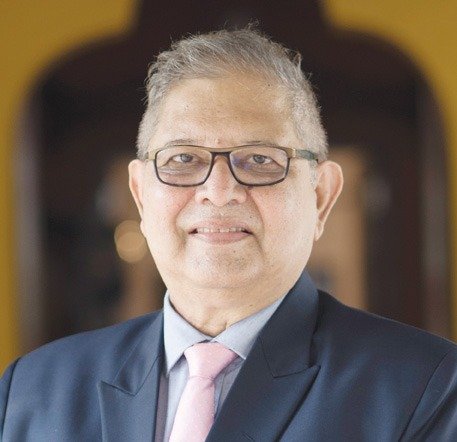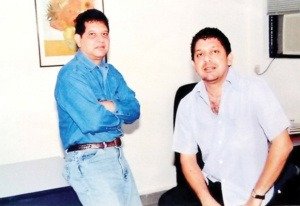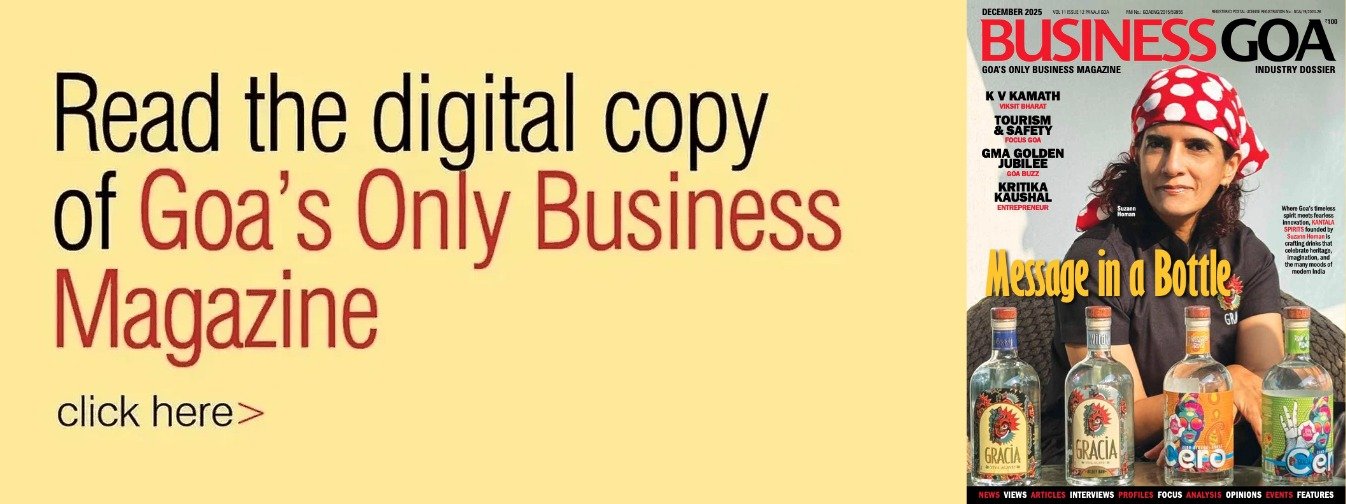
Ralph de Sousa, a travel and tourism entrepreneur, who has been part of various business organisations in Goa, has been elected as President of Goa Chamber of Commerce & Industry. His involvement with the Chamber spans almost two decades, and he is also on the Board of Governors, Government of India Ministry for Tourism’s Institute of Hotel Management, Porvorim. He speaks to Business Goa about the various challenges before the State’s economy, the fate of tourism in view of the pandemic, addressing the problem of the exodus of migrant labour, along with the Chamber’s plan to help small and medium entrepreneurs tide over this crucial period. Further, Ralph elaborates on the issue of taxi operators and digital meters, Goa’s heritage and how the tourism industry can use Goa’s rich biodiversity to its advantage, and plans to attract startups and the youth to the Chamber

You have been part of many business organisations in Goa. What inspires you to represent industry?
Being a first generation entrepreneur, my commitment to business, enterprise and its well-being is of great importance. By being a part of associations, we are able to address the issues faced by the industry with the government agencies and this helps entrepreneurs generate revenues for the State and create employment for the people.
Associations like the GCCI are a platform where collective wisdom prevails and this is so important to approach diverse issues faced by the members from a correct perspective. Collectively, we can achieve much more as joint deliberation gives us complete dimensions of the issues in question.
How has been your tenure at the Chamber and what has been your profile over the years?
I have been involved with the Chamber for almost two decades and I have served in various capacities. Although I have been the member of the Managing Committee for all these years, I have served as the chairman of the Tourism Committee for two terms, followed by my position among the office bearers, first as Hon Secretary, then as Vice President (Second) and later, Vice President (First).
This has given me an opportunity to work under various presidents coming from diverse industrial backgrounds and professions. Their wisdom to address the issues of the industry has been my greatest take away.
What are your primary goals as the newly elected president of the Chamber?
I succeed Manoj Caculo as the President of the Chamber in a troubled era. The pandemic has devastated the industry as well as retail in Goa and in the country. Various issues have surfaced and the new committee will have the task of addressing them with the government. Small businesses and retailers are hard hit as they normally don’t have huge reserves to fall back on; and our larger industries especially in the various industrial estates in Goa are facing all sorts of problems. Mitigation of these issues and our efforts to help put the industry and commerce back on rails will be the challenges that my team will have to deal with.
What are the various hurdles faced by Goa’s economy during the pandemic?
The pandemic has created huge losses to the business. Many industries are facing liquidity issues and difficulties in meeting financial commitments. On the other hand, the migrant labour who work in these enterprises have gone back to their home States. As we source all our raw material from out of Goa and our finished goods are marketed outside the State, the stoppage of transportation creates a dual challenge. Many ancillary industries that are suppliers to the larger industries are also experiencing a fall in production as the larger industry themselves are facing problems.
As a travel and tourism entrepreneur, you have been vocal about the industry. How do you see the fate of tourism in the State, what with uncertainty and the pandemic looming large on the fortunes of the sector?
Tourism is the worst affected industry in this pandemic. In case of any problems, the hospitality industry is the first to get affected and last to recover. 2017-18 has been a subdued year for tourism, as the economic downturn reflected in the fall of MICE tourism. Thereafter, it has been difficult trying to remain afloat inspite of the challenges of lockdowns, curfews and travel constraints imposed by the State to curtail the infections in this pandemic. There was a window opened last November, with the influx of domestic tourists making their way into Goa when the borders were opened; but unfortunately this was short lived, as by March, the second wave made its appearance. The industry now awaits to cautiously open its doors in the month of November, awaiting to welcome the travelers from the domestic market. Being a popular destination, Goa is fortunate to have huge number of repeat tourists who frequent our State for their holidays. We require a very strong professional body to plan and execute the revival of the tourism industry in Goa; and this is the right time to get the Goa Tourism Board up and running, with experienced trade professionals as its members so that the much required planning and direction which is vital for the industry, is in place and in the hands of industry professionals.
The lockdowns imposed due to covid have been a huge challenge for industry, with many workers fearing job loss and talking of migrating back to their hometowns, yet again. How do you wish to tackle the situation and advise the government?
The lockdowns imposed due to the pandemic have resulted in chaotic situations for the labour sector. Hordes of labour from all over the country migrated back to their native States in this time of uncertainties. The electronic media footage depicting this mass migration did not help the situation but increased a panic among the migrants. Unlike other States, things in Goa were much calmer and the migrant labour suffered minimum hardships. The State Government arranged trains to transport the migrants to their State and the Goa administration efficiently played their role to ensure safe travel for the labour. In our State, the migrant labourers were made comfortable in various labour camps that were established, with food and shelter being provided by the State, industry and the people of Goa.
The exodus from the State resulted in many factories being shut on one side and numerous workers losing their jobs on the other. When the first wave was addressed and in control, trains were recommissioned and many a labour came back to work. Before they could actually settle down, the second wave made its appearance, causing a flutter again – once more Goa saw migrants leaving the State; but this time, in much smaller numbers. One of the ways to ensure that this problem is addressed is to start a vaccination drive of the workers in all the industries. This will protect them from infections and raise the confidence of the workers, as well as their employers, which will result in uninterrupted production. Of course, taking every caution and respecting all norms preventing the spread of disease, vaccination is the answer and we have already started this in Goa.
Many small and medium entrepreneurs have lost their livelihoods, with zero income coming their way over the last 14-15 months. What is the Chamber’s plan to alleviate their misery?
MSMEs and small traders are one of the worst affected as their businesses almost came to a standstill. The Chamber has requested the State Government to come up with a rescue and revival package for this sector. The other suggestions like giving extended time limits to pay utility charges as well as taxes and levies have also been presented to the authorities.
It is the Chamber’s view that the State has to patronise small industries by purchasing all their requirements from these industries in Goa. This will, to an extent, boost their revenues.
Talking about tourism again, the recent cyclone has caused loss of huge amounts to the shacks and small hotels on the coastline…
The current paralysed season was further worsened by the cyclone that struck Goa recently. The shacks, as well as the coastal hotels and restaurants, suffered severe damage with many a roof blown off and structures damaged by fallen trees and electricity poles. The power and communication was disrupted for over a week and this further aggravated the devastation that the hospitality business is already facing. As the monsoons are here, restoration and repairs to the damaged property has to be undertaken on a war footing before the onset of the rains washes away whatever is left. This is the predicament faced by the players in the hospitality industry today.
The taxi operators are not in a mood to comply with affixing meters to their vehicles. The Chamber has been vocal in supporting the government. As a travel entrepreneur, what win-win situation can you suggest to break this impasse?
The Chamber is supporting the government because it is of the view that the taxis in every category should be fitted with digital fare meters. This will give a boost to the confidence of the customers that s/he is paying the legal fare, and it will also create a level playing field to the taxis operated by different companies.
It has been suggested to have just four categories for establishing the rates, the non AC, the standard AC, the premium AC and the limousine service taxis. The rates fixed should be such that they should not put the taxi driver out of his pocket and at the same time they should be affordable to the customers, be they, tourists or locals. This is important, as the self-drive cars and bikes on hire are available as an option.
Goa’s new Tourism Policy endeavours to focus on heritage and hinterland. As a heritage lover, how do you see this new idea panning out for the industry?
Goa is a small State offering various attractions. We have the warm waters of the Arabian Sea laced by world famous beaches. Our villages are where the soul of Goa resides – they are unique, self contained and prosperous. Our hinterland consists of rivers with their tributaries, palm groves, sluice gates, paddy fields, mango and cashew orchards, to mention a few. This is the tapestry of Goa’s hinterland. Beyond the hinterland, we have evergreen forests guarded by the Western Ghats where wildlife sanctuaries are nestled. This is God’s gift to Goa and if it has to be shared with our guests we have to approach this sector cautiously, giving due respect to the local culture, heritage and lifestyle. We have to be an inclusion rather than an intrusion, when we visit the hinterland. Development does not mean concretisation and all that is required is to preserve, conserve, encourage and support the local traditions and heritage that exists in their natural settings.
By encouraging home stays, we will not find the need for new hotels to make their presence in these areas. What better way to enjoy and understand a place than living with a family, being part of the local culture and enjoying the local village lifestyle.
The State Budget has allotted a measly Rs 10 crores for upgradation of infrastructure at industrial estates across the State…
We have industrial estates in every taluka and these are the cradles which have nursed the industries when they made their appearance in Goa. Over a period of time, they have grown in size and in the number of industries that they host. These are the hubs of the industrial sector in Goa. As time went by the infrastructure that was provided is renderred insufficient, and requires upgradation. As power, water, roads, and communication have not kept pace with the growth of the industry and hence many industries are forced to work under capacity, while the expansion programs and new industries coming up in these estates have been delayed. What the estates require is boost in infrastructure, transparency in its administration and total upgradation in the facilities that will ensure that the present as well as the future industry will run without hiccups. The decades old infrastructure is falling apart and the tired looking facilities are not going to survive for long, hence proper budgetary allocations are the need of the hour for the smooth running of the industry and for the prosperity of Goa.
What ideas do you cherish about the various Presidents with whom you have worked at GCCI?
I had the privilege of being a part of the team of six Chamber presidents and they were all a great source of confidence and knowledge which impacted all of us.
While Nitin Kunkolienkar was a man of energy and dynamism, Cesar Menezes was a source of calmness and wisdom. Manguirish Pai Raikar showed patience in times of pressure and was the voice of small traders. Nana Bandekar, an able administrator, was meticulous in his dealings and was respected by the members for his constant assistance. Sandeep Bhandare is a professional and he dealt with the issues presented to him very meticulously with in-depth analysis leading to viable solutions, while my predecessor Manoj Caculo was at the helm of the Chamber for past two troubled years and he navigated the affairs with grit and determination.
What more can we take home other than the above traits that our past presidents have shared with us through actions and by example.
How do you plan to attract young entrepreneurs and startups to the Chamber?
We intend to work closely with the various existing platforms that encourage and mentor startups in Goa. We will explore the possibility of bringing them in as an integral part of the Chamber’s industry committee. The Chamber can thus act as a facilitator, take the issues with the authorities and be a bridge between the startups and the State government. By involving startup entrepreneurs, we can come up with a profile of their requirements and get it addressed by the State authorities or create a synergy with banks or financial institutions to help address their financial requirements. This way, the required assistance can be availed in the precise areas stated in the profile.
The sub-committees at the Chamber are the organisation’s key strength. Tell us about your plans for the same.
Yes indeed. The sub committees are the foundation on which the Chamber’s activities rest. Inspite of the paralysis in the economy that we are facing today, many of our committees with the chairpersons and their members have come up with various suggestions and policies not only to mitigate the current problems but to shape up the things in the future. There is a system that has been recently introduced where once a month the chairpersons of various committees interact with the managing committee to discuss the issues faced by the respective sectors – and this system will continue. The changes and reshuffles brought in by the pandemic have also brought to the fore the prominence of the pharma and healthcare sector as well as medical fraternity. These sectors will be given due importance when we restructure the Chamber’s committees
Ralph de Sousa is the Chairman of the de Souza Group, a business house engaged principally in hospitality business – owning resorts, travel agencies and tour operators. The Group also owns a construction company and service apartments being the latest addition to its activities.
Ralph is on the Board of Governors, Govt. of India Ministry for Tourism’s Institute of Hotel Management, Porvorim; and has been recently elected as President of Goa Chamber of Commerce & Industry.
The Government of Goa has appointed him on the Board of Directors of Economic Development Corporation (EDC) of the State of Goa, where he was also the former Task Force Member of the Chief Minister’s Rozgar Yojna (CMRY), the micro finance body of the State of Goa, for 7 years. Recently he has been appointed as a Board Member of the Goa Investment Promotion Board.
Ralph previously held the positions as the Chairman of the Goa America Heart Foundation Trust, President of Travel & Tourism Association of Goa, Chairman and Patron of Goa Heritage Action Group, Trustee of The Museum of Christian Art. He was also Past Chairman of Confederation of Indian Industry – Goa Council.
He has served on various leadership positions at GCCI for nearly two decades.
Ralph belongs to the village of Assagao. He lives in Saligao with his wife Carolina, a former secondary school teacher who completed 30 years of service at St. Mary’s High School, Mapusa, and his two children Carlos Noel and Karla Maris
GOA CHAMBER ELECTS NEW MANAGING COMMITTEE FOR 2021-23
The elections for the post of President and 14 Managing Committee Members of Goa Chamber of Commerce and Industry for the term 2021-23 were held recently.
While Ralph de Sousa was earlier elected unopposed as President for the term 2021-23, the 14 posts for the Managing Committee were also elected unopposed.
The newly elected members are: Ashutosh Kharangate (Managing Director, Mangal Analytics & Research Consulting Pvt. Ltd.); Chandrakant Gawas (Prop., Sagar Marine Services); Dhirendra Thakker (Partner, Hiralal & Co.); Girish Bharne (Vice President, Persistent Systems Ltd); Goutam Raj (Plant Head, MRF Ltd); Harshvardhan V. Sinai Bhatkuly (Director, Business Goa); Dr. Jennifer Lewis e Kamat (Partner, Kamat Infra Tech); John Joseph D’Souza (Prop., Dsouza Biotech); Pratima Dhond (Prop., Swadeshi Bhandar); Rajesh Dempo (Managing Director, Vision Dempo Hospitality & Estates Pvt. Ltd.); Salil Kare (Partner, Drogaria Salcete); Dr. Sangam Kurade (Chairman & MD, Zuari Foods & Farms Pvt. Ltd); Shrinivas Dempo (Chairman, Goa Carbon Ltd.); Yatin G. Kakodkar (Director, Apex Packaging Products P. Ltd)





